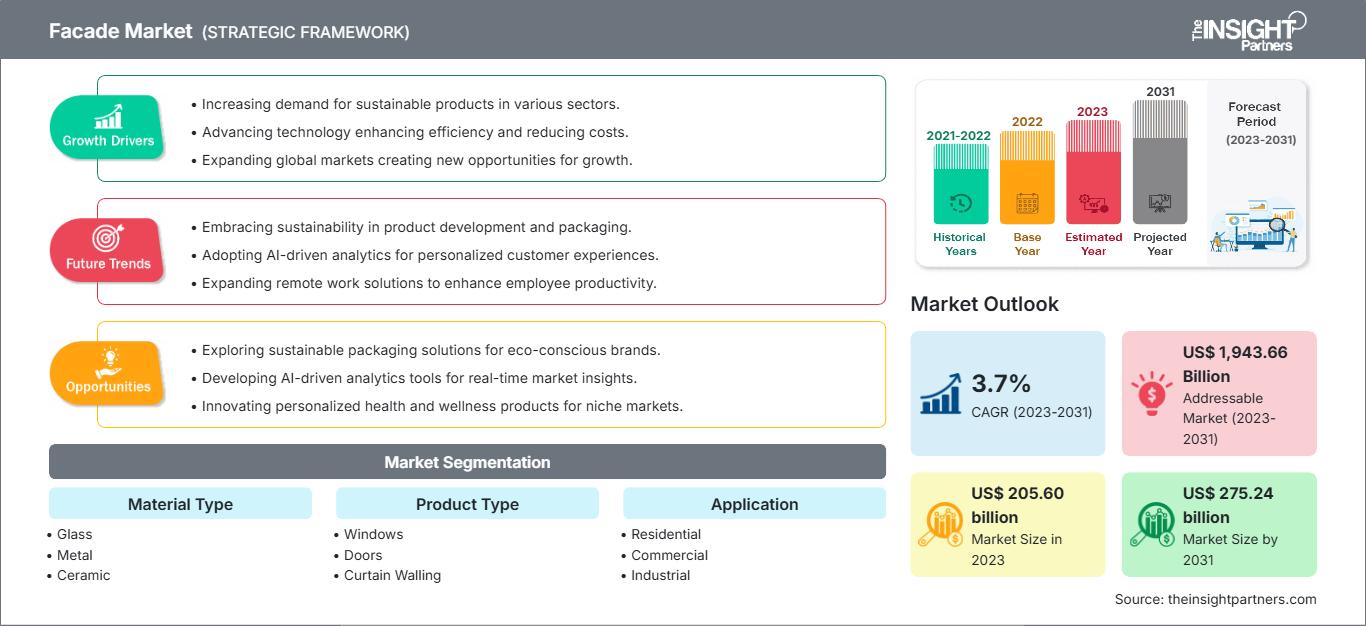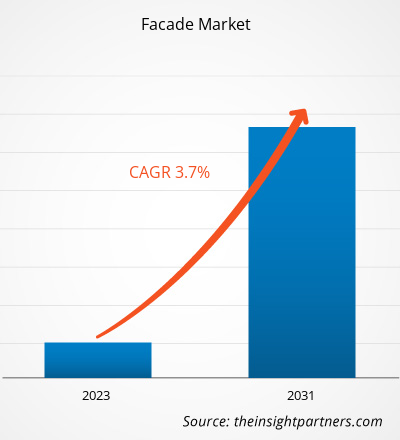Der Fassadenmarkt soll Prognosen zufolge von 205,60 Milliarden US-Dollar im Jahr 2023 auf 275,24 Milliarden US-Dollar im Jahr 2031 anwachsen. Für den Zeitraum 2023–2031 wird ein durchschnittliches jährliches Wachstum (CAGR) von 3,7 % erwartet. Die weltweit wachsende Bauindustrie wird voraussichtlich ein wichtiger Markttrend für Fassaden bleiben.
Marktanalyse für Fassaden
Intelligentes Gebäudedesign in der Bauindustrie ist eng mit Nachhaltigkeit verknüpft. Die Anwendung intelligenter Elemente auf zukünftige Fassaden umfasst die Auswahl und Erprobung verschiedener Technologien, um die Qualität und Leistungsfähigkeit eines Fassadensystems zu verbessern. Außerdem werden fortschrittliche Technologien integriert, um Fassaden aufzuwerten und den Wert und die Funktionalität von Gebäuden zu steigern. Eine Fassade gilt als intelligent, wenn sie sich an Umgebungsbedingungen anpassen und entsprechend verändern kann, vorbehaltlich der Einstellbarkeit und Anpassungsfähigkeit der Komponenten an unterschiedliche Bedingungen innerhalb und außerhalb des Gebäudes. Intelligente Fassaden umfassen auch intelligente Verglasungen, die das Sonnenlicht maximieren und gleichzeitig vor Sonneneinstrahlung schützen sowie bei Bedarf Lüftung und Heizung steuern.
Marktübersicht Fassaden
Die wachsende Bauindustrie, die durch günstige staatliche Unterstützung und eine steigende Tendenz zum Bau umweltfreundlicher Gebäude gefördert wird, wirkt sich auf Infrastrukturprojekte aus und treibt das Wachstum des Fassadenmarktes voran. Auch die Verbreitung von modernem Dämmmaterial, weichmacherfreiem Polyvinylchlorid (UPVC) und Doppelfassaden ist höher als bei anderen Materialien, da sie die Energieeffizienz eines Gebäudes verbessern. Darüber hinaus wird mit dem Aufkommen hochentwickelter Technologien wie vorgefertigten Fassadenplatten in der Fassade ein Wachstum der Bauindustrie in den kommenden Jahren prognostiziert.
Nach Material ist der globale Fassadenmarkt in Glas, Metall, Keramik, Holz und andere segmentiert. Das Metallsegment wird weiter in Aluminium, Kupfer, Stahl und andere unterteilt. Das Metallsegment hatte 2023 aufgrund der zunehmenden Verbreitung in gewerblichen Anwendungen den größten Marktanteil. Nach Anwendung ist der Markt in Wohn-, Gewerbe- und Industriebereiche unterteilt. Das kommerzielle Segment dominierte den Marktanteil im Jahr 2023, da die Fassade ein traditionelles System ist, das im Bauwesen zur Verbesserung der Ästhetik eingesetzt wird.
Passen Sie diesen Bericht Ihren Anforderungen an
Sie erhalten kostenlos Anpassungen an jedem Bericht, einschließlich Teilen dieses Berichts oder einer Analyse auf Länderebene, eines Excel-Datenpakets sowie tolle Angebote und Rabatte für Start-ups und Universitäten.
Fassadenmarkt: Strategische Einblicke

-
Holen Sie sich die wichtigsten Markttrends aus diesem Bericht.Dieses KOSTENLOSE Beispiel umfasst Datenanalysen, die von Markttrends bis hin zu Schätzungen und Prognosen reichen.
Markttreiber und -chancen für Fassaden
Umwelt- und energiebezogene Vorteile von Fassaden treiben das Marktwachstum an
Ein Fassadensystem ist ein wesentlicher Bestandteil der Gesamtkonstruktion eines Gebäudes und verleiht ihm einzigartige Eigenschaften. Die Fassade schützt das Gebäude vor Schäden durch starken Wind und heftigen Regen sowie vor extremen Temperaturen und Feuchtigkeit. Sie schützt außerdem vor ultraviolettem Sonnenlicht und bietet natürliche Belüftung. Komponenten eines Fassadensystems wie Dächer, Wände, Türen und Fenster regeln den Luftein- und -austritt und spielen eine Schlüsselrolle bei der Reduzierung des Eindringens von Staub und anderen luftgetragenen Partikeln in das Gebäude. Durch die intelligente Verknüpfung von Außen- und Innenbereich des Gebäudes trägt die Fassade dazu bei, Lichteinfall bzw. -filterung, Wärmeregulierung und Solarenergie-Minimierung zu steuern, was zu energieeffizienten Gebäuden mit höherem Sonnenschutz und passiver Kühlung führt.
Laut dem Umweltprogramm der Vereinten Nationen verbrauchen Gebäude und deren Bau jährlich über 36 % der weltweiten Energie und verursachen ca. 40 % der weltweiten Treibhausgasemissionen. Verschiedene wichtige Akteure integrieren funktionale Fassaden, darunter Vorhangfassaden, die sich positiv auf die Energieeffizienz auswirken und eine hohe Widerstandsfähigkeit gegen Witterungseinflüsse, Hitze, Lärm, Licht und Blendung bieten. Diese inhärenten Eigenschaften moderner Fassaden und die weltweit zunehmenden Umwelt- und Energiebedenken fördern das Wachstum des globalen Fassadenmarktes.
Wachsende Investitionen in Infrastrukturentwicklungsprojekte
Wachsende Investitionen in Infrastrukturentwicklungsprojekte weltweit treiben das Marktwachstum voran. So erhielt beispielsweise die Europäische Exekutivagentur für Klima, Umwelt und Infrastruktur im Januar 2024 ∼ 400 Anträge mit 20 Milliarden US-Dollar für Verkehrsinfrastrukturprojekte. China weist eine der höchsten Urbanisierungsraten der Welt auf. Laut Daten des American Institute of Architects (AIA) Shanghai wird in China bis 2025 voraussichtlich eine Fläche von zehn Städten in der Größe New Yorks errichtet worden sein. Laut der International Trade Administration (ITA) legt Chinas 14. Fünfjahresplan den Schwerpunkt auf neue Infrastrukturprojekte in den Bereichen Energie, Transport, Wassersysteme und Urbanisierung.
Intelligentes Fassadendesign macht es interaktiver und flexibler. Die breite und vielseitige Anpassungsfähigkeit und die Innovationen im interaktiven Fassadendesign werden in naher bis mittelfristiger Zukunft einen immer größeren Spielraum für das Wachstum des Fassadenmarktes schaffen. Darüber hinaus werden umfangreiche Forschung und Kapital in die Entwicklung fortschrittlicher Fassadensysteme investiert, wobei der Schwerpunkt auf Verglasungssystemen und verschiedenen Wandtypen liegt.
Segmentierungsanalyse des Fassadenmarktberichts
Schlüsselsegmente, die zur Ableitung der Fassadenmarktanalyse beigetragen haben, sind Material, Produkttyp und Anwendung.
- Basierend auf dem Material ist der globale Fassadenmarkt in Glas, Metall, Keramik, Holz und andere segmentiert. Der Markt für das Metallsegment ist weiter segmentiert in Aluminium, Kupfer, Stahl und andere. Das Metallsegment hatte im Jahr 2023 aufgrund der zunehmenden Verbreitung in gewerblichen Anwendungen den größten Marktanteil.
- Basierend auf dem Produkttyp ist der Fassadenmarkt in Fenster, Türen, Vorhangfassaden und andere segmentiert. Der Bausektor weltweit erlebt ein deutliches Wachstum. Mit dem Bau hoher Gebäude und größerer Bodenplatten suchen Endverbraucher nach fortschrittlichen Schalungssystemen, die leicht, wiederverwendbar, kostengünstig, langlebig, flexibel und einfach zu montieren und zu demontieren sind.
- Nach Anwendung ist der Markt in Wohn-, Gewerbe- und Industriebereiche unterteilt. Das Gewerbesegment dominierte den Marktanteil im Jahr 2023, da die Fassade ein traditionelles System ist, das im Bauwesen zur Verbesserung der Ästhetik eingesetzt wird.
Marktanteilsanalyse für Fassaden nach Geografie
Der geografische Umfang des Fassadenmarktberichts ist hauptsächlich in fünf Regionen unterteilt: Nordamerika, Asien-Pazifik, Europa, Naher Osten und Afrika sowie Süd- und Mittelamerika.
Im Jahr 2023 hielt der Asien-Pazifik-Raum den größten Umsatzanteil am globalen Fassadenmarkt. Aufgrund von Faktoren wie der zunehmenden Urbanisierung und Industrialisierung wird für die Region im Prognosezeitraum eine moderate Wachstumsrate des globalen Fassadenmarktes erwartet. Die große Bevölkerung in der Region hat eine hohe Nachfrage nach Gewerbe- und Wohnungsbau geschaffen. Darüber hinaus nehmen die Bauaktivitäten in Südostasien deutlich zu, was das Wachstum des Fassadenmarktes in der Region unterstützen dürfte.
Fassade
Regionale Einblicke in den FassadenmarktDie Analysten von The Insight Partners haben die regionalen Trends und Faktoren, die den Fassadenmarkt im Prognosezeitraum beeinflussen, ausführlich erläutert. In diesem Abschnitt werden auch die Marktsegmente und die geografische Lage in Nordamerika, Europa, dem asiatisch-pazifischen Raum, dem Nahen Osten und Afrika sowie Süd- und Mittelamerika erörtert.
Umfang des Fassadenmarktberichts
| Berichtsattribut | Einzelheiten |
|---|---|
| Marktgröße in 2023 | US$ 205.60 billion |
| Marktgröße nach 2031 | US$ 275.24 billion |
| Globale CAGR (2023 - 2031) | 3.7% |
| Historische Daten | 2021-2022 |
| Prognosezeitraum | 2023-2031 |
| Abgedeckte Segmente |
By Materialtyp
|
| Abgedeckte Regionen und Länder |
Nordamerika
|
| Marktführer und wichtige Unternehmensprofile |
|
Dichte der Marktteilnehmer im Fassadenbereich: Verständnis ihrer Auswirkungen auf die Geschäftsdynamik
Der Fassadenmarkt wächst rasant, angetrieben durch die steigende Endverbrauchernachfrage aufgrund von Faktoren wie sich entwickelnden Verbraucherpräferenzen, technologischem Fortschritt und einem stärkeren Bewusstsein für die Produktvorteile. Mit steigender Nachfrage erweitern Unternehmen ihr Angebot, entwickeln Innovationen, um den Verbraucherbedürfnissen gerecht zu werden, und nutzen neue Trends, was das Marktwachstum weiter ankurbelt.

- Holen Sie sich die Fassadenmarkt Übersicht der wichtigsten Akteure
Neuigkeiten und aktuelle Entwicklungen auf dem Fassadenmarkt
Der Fassadenmarkt wird durch die Erhebung qualitativer und quantitativer Daten aus Primär- und Sekundärforschung bewertet, die wichtige Unternehmensveröffentlichungen, Verbandsdaten und Datenbanken umfasst. Nachfolgend finden Sie eine Liste der Entwicklungen auf dem Fassadenmarkt:
- Saint-Gobain, ein weltweit führendes Unternehmen im Bereich leichtes und nachhaltiges Bauen, gab seine Partnerschaft mit „Build Ahead“ bekannt, einer von Xynteo gegründeten, unternehmensgeführten Koalition. Dieses zweckorientierte Beratungsunternehmen unterstützt die weltweit größten Organisationen dabei, menschen- und umweltverträgliche Wachstumsmöglichkeiten zu finden. Die Partnerschaft wurde während der wichtigsten Veranstaltung der Koalition, „The Exchange“, am 15. Februar 2024 in Neu-Delhi bekannt gegeben. (Unternehmenswebsite von Saint Gobain SA, Februar 2024)
- Saint-Gobain Glass hat ORAE in sein Portfolio integriert. Die Lösung COOL-LITE XTREME ORAE bietet Leistung und Nachhaltigkeit und reduziert den Betriebsaufwand (Kühlung, Heizung und Beleuchtung bei der Nutzung eines Gebäudes) und den in Gebäudefassaden enthaltenen Kohlenstoff. (Website des Unternehmens Saint Gobain SA, 2022)
Bericht zum Fassadenmarkt – Abdeckung und Ergebnisse
Bericht zum Fassadenmarkt – Abdeckung und Ergebnisse
Der „Marktgröße und -prognose für Fassaden (2021–2031)“ Der Bericht bietet eine detaillierte Analyse des Marktes und deckt die folgenden Bereiche ab:
- Marktgröße und Prognose für Fassaden auf globaler, regionaler und Länderebene für alle wichtigen Marktsegmente, die in den Geltungsbereich fallen
- Markttrends und Marktdynamiken für Fassaden wie Treiber, Einschränkungen und wichtige Chancen
- Detaillierte PEST- und SWOT-Analyse
- Marktanalyse für Fassaden, die wichtige Markttrends, globale und regionale Rahmenbedingungen, wichtige Akteure, Vorschriften und aktuelle Marktentwicklungen umfasst
- Branchenlandschaft und Wettbewerbsanalyse, die Marktkonzentration, Heatmap-Analyse, prominente Akteure und aktuelle Entwicklungen für den Fassadenmarkt umfasst
- Detaillierte Unternehmensprofile
- Historische Analyse (2 Jahre), Basisjahr, Prognose (7 Jahre) mit CAGR
- PEST- und SWOT-Analyse
- Marktgröße Wert/Volumen – Global, Regional, Land
- Branchen- und Wettbewerbslandschaft
- Excel-Datensatz
Aktuelle Berichte
Erfahrungsberichte
Grund zum Kauf
- Fundierte Entscheidungsfindung
- Marktdynamik verstehen
- Wettbewerbsanalyse
- Kundeneinblicke
- Marktprognosen
- Risikominimierung
- Strategische Planung
- Investitionsbegründung
- Identifizierung neuer Märkte
- Verbesserung von Marketingstrategien
- Steigerung der Betriebseffizienz
- Anpassung an regulatorische Trends






















 Kostenlose Probe anfordern für - Fassadenmarkt
Kostenlose Probe anfordern für - Fassadenmarkt